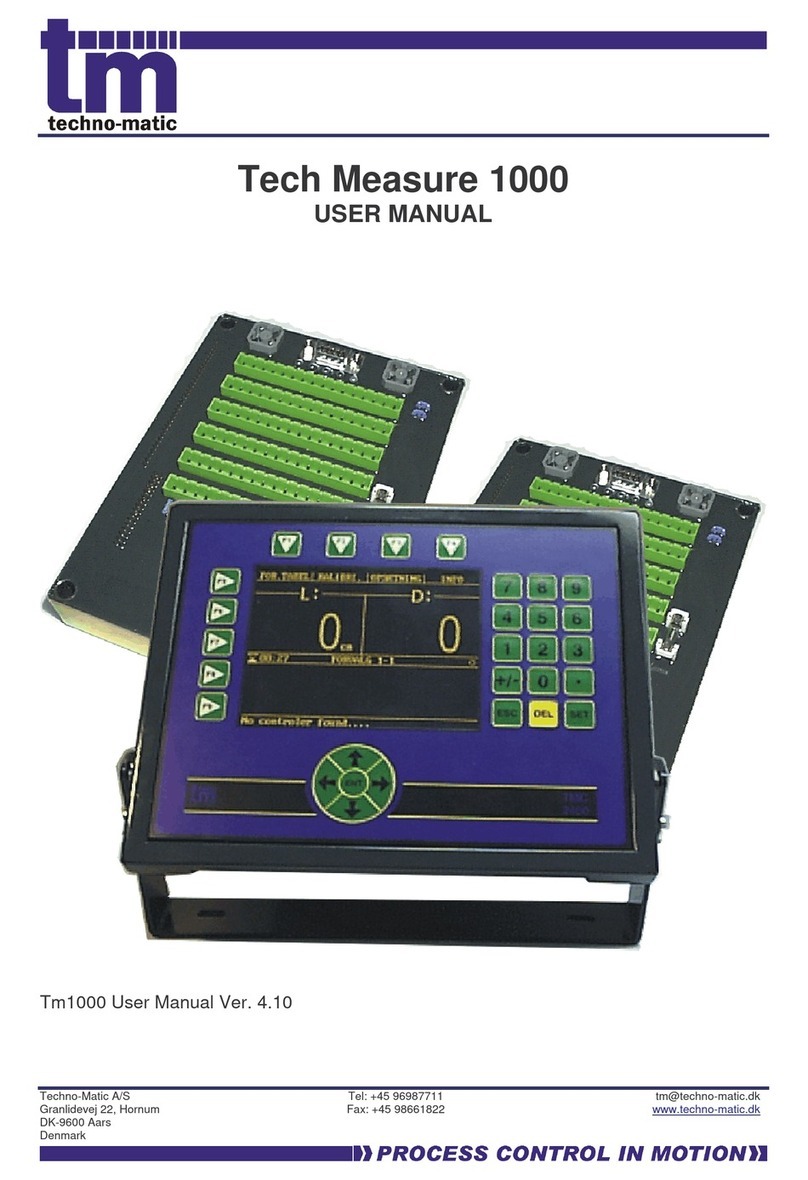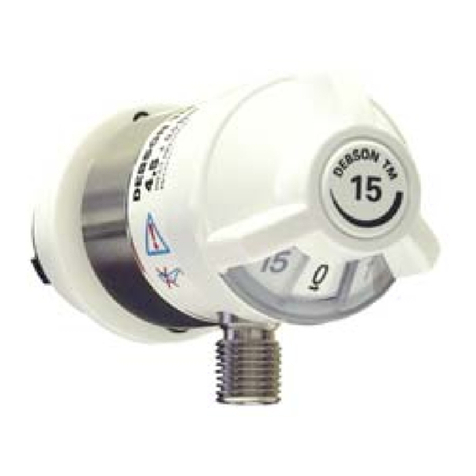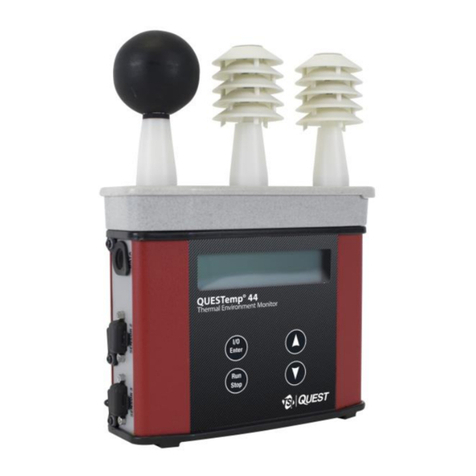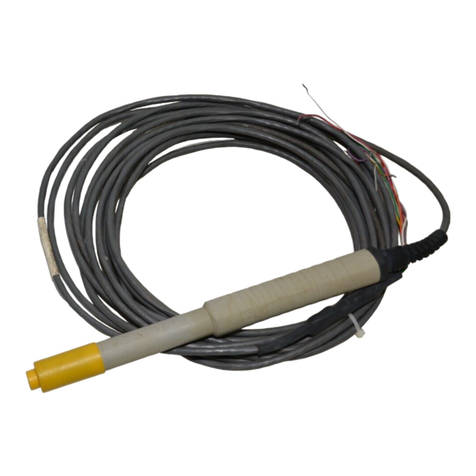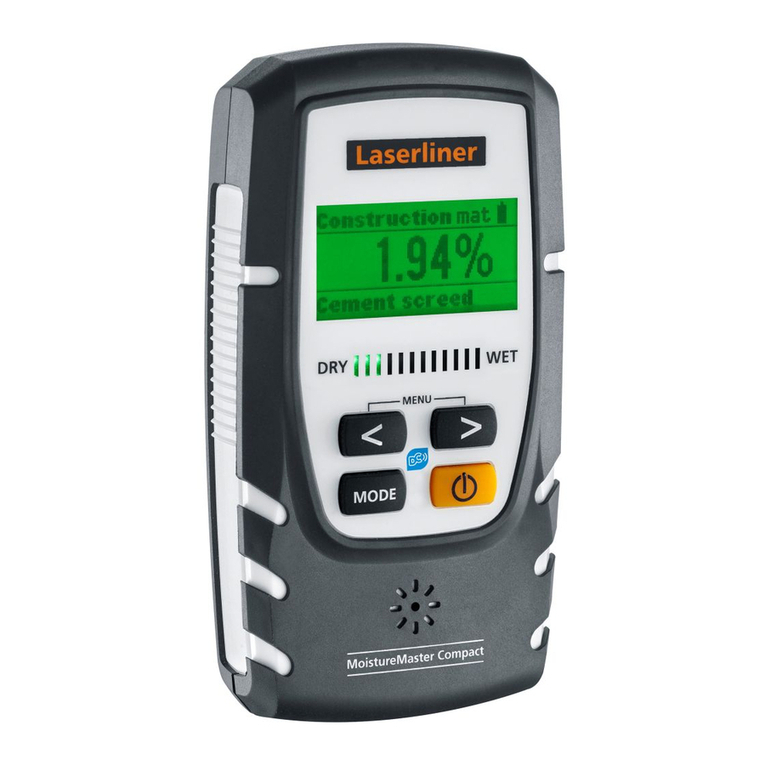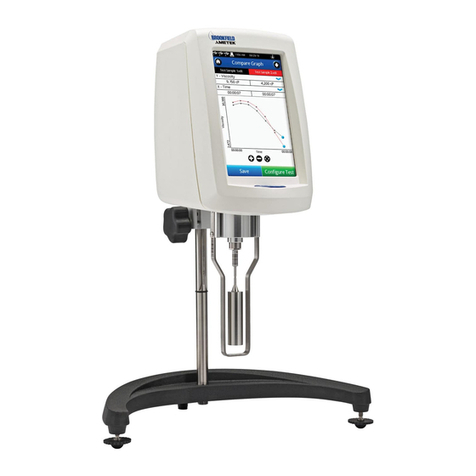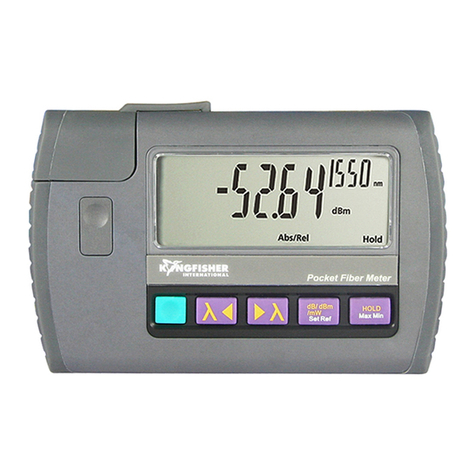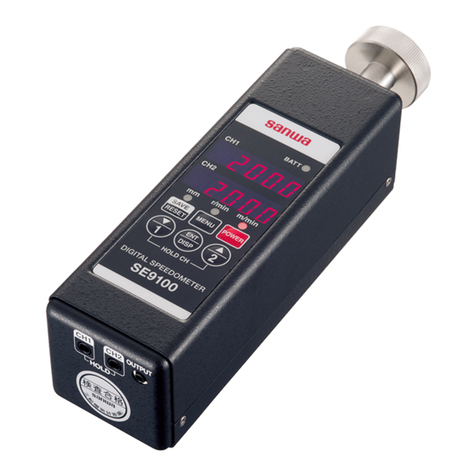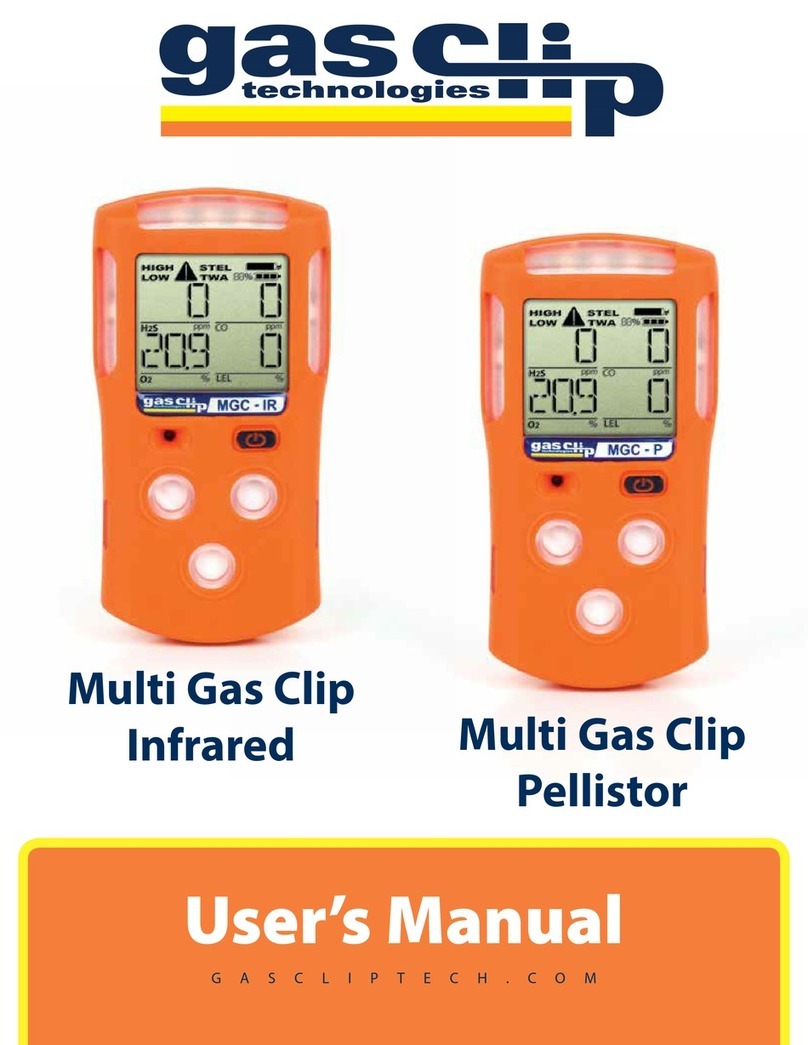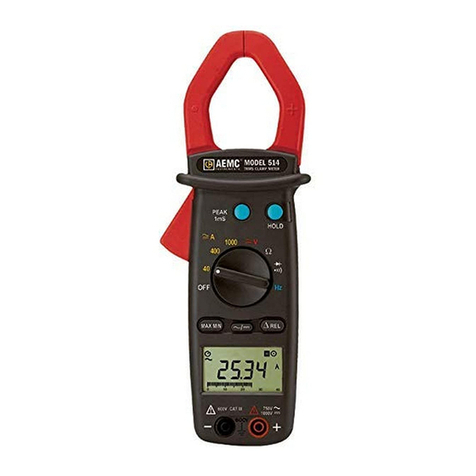TM 9-1829A Guide

TM 9-1829A, April 1944 1/100 2021-07-07
TM 9-1829A
War department
Ordnance Maintenance
Speedometers, Tachometers and
Recorders

TM 9-1829A, April 1944 2/100 2021-07-07
Contents
Chapter 1: Introduction...........................................................................................................................................7
1. Purpose and scope.....................................................................................................................................7
Chapter 2: Magnetic-type speedometers and tachometers; description, operation identification and testing.........7
2. Description and operation .........................................................................................................................7
3. Identification...........................................................................................................................................11
4. Bench test procedure...............................................................................................................................12
Chapter 3: AC division of general motors speedometers and tachometers...........................................................15
5. Description..............................................................................................................................................15
6. Disassembly............................................................................................................................................17
7. Cleaning, inspection, and repair of parts.................................................................................................18
8. Assembly.................................................................................................................................................19
9. Calibration...............................................................................................................................................21
Chapter 4: Auto-Lite speedometers and tachometers...........................................................................................23
Section I: SPA series........................................................................................................................................23
10. Description............................................................................................................................................23
11. Disassembly ..........................................................................................................................................23
12. Cleaning, inspection, and repair of parts...............................................................................................25
13. Assembly...............................................................................................................................................26
14. Calibration.............................................................................................................................................29
Section II: SPJ, SPL and SPM series ...............................................................................................................31
15. Description............................................................................................................................................31
16. Disassembly ..........................................................................................................................................31
17. Cleaning, inspection, and repair of parts...............................................................................................32
18. Assembly...............................................................................................................................................32
Section III: SPK, SPP and SPR Series.............................................................................................................34
19. Description............................................................................................................................................34
20. Disassembly ..........................................................................................................................................35
21. Cleaning, inspection, and repair of parts...............................................................................................37
22. Assembly...............................................................................................................................................37
Chapter 5: King-Seeley speedometer ...................................................................................................................38
24. Disassembly ..........................................................................................................................................38
25. Cleaning, inspection, and repair of parts...............................................................................................40
26. Assembly...............................................................................................................................................40
27. Calibration.............................................................................................................................................42
Chapter 6: Stewart warner speedometers and tachometers...................................................................................43
Section I: Speedometers with cup-type magnets..............................................................................................43
28. Description............................................................................................................................................43
29. Disassembly ..........................................................................................................................................43
30. Cleaning, inspection, and repair of parts...............................................................................................48
31. Assembly and calibration......................................................................................................................49
Section II: Speedometers and tachymeters with flat disk-type magnets..........................................................56
32. Description............................................................................................................................................56
33. Disassembly ..........................................................................................................................................57
34. Cleaning, inspection and repair of parts................................................................................................62
35. Assembly and calibration......................................................................................................................62
Section III: Centrifugal tachometers................................................................................................................70
36. Description and operation .....................................................................................................................70
37. Bench test procedure.............................................................................................................................71
38. Disassembly ..........................................................................................................................................72
39. Cleaning, inspection, and repair of parts...............................................................................................73
40. Assembly and calibration......................................................................................................................74
Chapter 7: Waltham speedometers .......................................................................................................................76
41. Description............................................................................................................................................76
42. Disassembly ..........................................................................................................................................76
43. Cleaning, inspection, and repair of parts...............................................................................................77
44. Assembly and calibration......................................................................................................................78
Chapter 8: Stewart-Warner recorders ...................................................................................................................80

TM 9-1829A, April 1944 3/100 2021-07-07
45. Description............................................................................................................................................80
46. Operation...............................................................................................................................................81
47. Disassembly ..........................................................................................................................................81
48. Cleaning, inspection, and repair of parts...............................................................................................82
49. Assembly...............................................................................................................................................82
50. Description............................................................................................................................................83
51. Operation...............................................................................................................................................83
52. Repair of flexible shafts ........................................................................................................................83
Chapter 10: AC speed adapters.............................................................................................................................88
53. Function ................................................................................................................................................88
54. Application............................................................................................................................................88
55. Disassembly, repair, and assembly .......................................................................................................88
Chapter 11: Stewart-Warner drive joints..............................................................................................................89
Section I: 666-type drive joints........................................................................................................................89
56. Description............................................................................................................................................89
57. Operation...............................................................................................................................................90
58. Disassembly ..........................................................................................................................................90
59. Cleaning and inspection........................................................................................................................91
60. Assembly...............................................................................................................................................92
Section II: 659-type drive joints.......................................................................................................................94
61. Description............................................................................................................................................94
62. Operation...............................................................................................................................................94
63. Repair....................................................................................................................................................94
Chapter 12: Special tools......................................................................................................................................95
64. Special tools..........................................................................................................................................95
Chapter 13: Calibrating machine..........................................................................................................................98
65. Description............................................................................................................................................98
66. Operation...............................................................................................................................................98
67. Lubrication............................................................................................................................................99
References ..........................................................................................................................................................100
Standard nomenclature list.............................................................................................................................100
Explanatory publications ...............................................................................................................................100
General......................................................................................................................................................100
Related technical manuals.........................................................................................................................100
Decontamination.......................................................................................................................................100

TM 9-1829A, April 1944 4/100 2021-07-07
Figures
Figure 1: Speedometer............................................................................................................................................7
Figure 2: Speedometer installation .........................................................................................................................8
Figure 3: Flexible shaft...........................................................................................................................................8
Figure 4: Tachometer..............................................................................................................................................8
Figure 5: Phantom view of basic components of speed-indicating portion of speedometer...................................9
Figure 6: Phantom view of speedometer ..............................................................................................................10
Figure 7: Schematic view of total odometer.........................................................................................................10
Figure 8: Schematic view of a trip odometer........................................................................................................11
Figure 9: Rear of AC speedometer .......................................................................................................................11
Figure 10: Rear of Auto-Lite Speedometer ..........................................................................................................11
Figure 11: Front and rear of King-Seeley speedometer........................................................................................12
Figure 12: Rear of Stewart-Warner Speedometer.................................................................................................12
Figure 13: Waltham speedometer.........................................................................................................................12
Figure 14: Testing for tight mechanism................................................................................................................13
Figure 15: AC speedometer disassembled............................................................................................................15
Figure 16: AC tachometer disassembled ..............................................................................................................16
Figure 17: Speedometer mechanism (dial removed) ............................................................................................16
Figure 18: Quick reset trip odometer removed from frame..................................................................................17
Figure 19: Removing second gear from frame .....................................................................................................18
Figure 20: Removing magnet shaft collar, using dismantling wrench (T-170654) ..............................................18
Figure 21: Pressing collar on magnet shaft, using fixture (T-170666 with Det. 1)...............................................19
Figure 22: Flaring magnet shaft, using fixture (T-170666 with Det. 6) ...............................................................20
Figure 23: Charging AC speedometer or tachometer magnet, using magnetizer (846294)..................................21
Figure 24: Auto-Lite speedometer (SPA-type), disassembled..............................................................................23
Figure 25: SPA-type speedometer mechanism (dial removed).............................................................................23
Figure 26: Removing hair spring, using puller (T-66296)....................................................................................24
Figure 27: Making clearance for hair spring puller with lifter (T-29 Det. 3) .......................................................24
Figure 28: Removing second gear........................................................................................................................25
Figure 29: Removing magnet shaft collar, using dismantling wrench (T-170654) ..............................................25
Figure 30: Stacking intermediate gear, using fixture (T-178717).........................................................................26
Figure 31: Pressing collar on magnet shaft, using fixture (T-170666 with Det. 1)...............................................27
Figure 32: Flaring magnet shaft, using fixture (T-170666 with Det. 6) ...............................................................27
Figure 33: Adjusting front jewel, using special tool (T-178705)..........................................................................27
Figure 34: Checking speed cup staff end play, using feeler gage (ST-263-27)....................................................28
Figure 35: Charging magnet, using Magnetizer (846294)....................................................................................29
Figure 36: Auto-Lite speedometer (SPJ, SPL and SPM-type), disassembled ......................................................31
Figure 37: Auto-Lite speedometer (SPK- and SPR-types), disassembled............................................................34
Figure 38: Auto-Lite tachometer (SPP-type), disassembled.................................................................................34
Figure 39: SPK-type speedometer mechanism (dial removed).............................................................................35
Figure 40: Removing field plate and speed cup....................................................................................................35
Figure 41: Removing second gear, using extractor (ST-263-34)..........................................................................36
Figure 42: Removing magnet shaft collar, using dismantling wrench (T-170654) ..............................................36
Figure 43: Staking second gear bushing, using installer (ST-263-35)..................................................................37
Figure 44: King-Seeley speedometer, disassembled.............................................................................................38
Figure 45: Speedometer mechanism (dial removed) ............................................................................................39
Figure 46: Removing hair spring, using Puller (T-66296)....................................................................................39
Figure 47: Removing magnet shaft collar, using dismantling wrench (T-170654) ..............................................40
Figure 48: Flaring magnet shaft, using fixture (T-170666 with Det. 6) ...............................................................41
Figure 49: Applying thumb pressure on magnet shaft while adjusting front jewel with special tool (T-178705)41
Figure 50: Stewart-Warner speedometer with cup-type magnet disassembled ....................................................43
Figure 51: Tearing out section of rolled bezel......................................................................................................44
Figure 52: Pullig off rolled bezel..........................................................................................................................44
Figure 53: Removing disk-type pointer, using special puller (T-131105)............................................................44
Figure 54: Speedometer mechanism (dial removed) ............................................................................................44
Figure 55: Speedometer mechanism with odometers in line ................................................................................45
Figure 56: Speedometer mechanism (odometers removed)..................................................................................45

TM 9-1829A, April 1944 5/100 2021-07-07
Figure 57: Removing hair spring pin....................................................................................................................45
Figure 58: Removing hair spring, using puller (T-66296)....................................................................................46
Figure 59: Front jewel assembly...........................................................................................................................46
Figure 60: Removing magnet shaft collar, using dismantling wrench (T-170654) ..............................................46
Figure 61: Smoothing out flare in magnet shaft, using fixture (T-170666 with Det. 7).......................................47
Figure 62: Removing burs from magnet shaft......................................................................................................47
Figure 63: Staking intermediate gear, using fixture (T-178717) ..........................................................................48
Figure 64: Removing oil wick plug......................................................................................................................48
Figure 65: Pressing collar on magnet shaft, using fixture (T-170666 with Det. 1)...............................................49
Figure 66: Flaring magnet shaft, using fixture (T-170666 with Det. 6) ...............................................................49
Figure 67: Replacing oil wick plug.......................................................................................................................50
Figure 68: Adjusting front jewel, using special tool (T-178705)..........................................................................50
Figure 69: Magnet strength tester (408165, on frame and magnet assembly) attached to calibrating machine (T-
170645).................................................................................................................................................................51
Figure 70: Replacing hair spring, using assembly kit (T-29) ...............................................................................52
Figure 71: Adjusting hair spring tension by turning collet on staff, using adjuster (T-51742).............................53
Figure 72: Aligning total odmeter figure wheels with dial window, using spanner wrench (T-40783) ...............53
Figure 73: Holding speedometer on calibrating machine (T-170645) and testing at 30 mph...............................54
Figure 74: Placing upper die of Bezel rolling fixture (T-178730) over speedometer...........................................55
Figure 75: Rolling bezel with fixture (T-178730) in arbor press..........................................................................55
Figure 76: Stewart-Warner speedometer with flat disk-type magnet disassembled .............................................56
Figure 77: Driving off pressed-on bezel, using remover (T-42358).....................................................................57
Figure 78: Removing pointer................................................................................................................................57
Figure 79: Removing elbow joint screw...............................................................................................................58
Figure 80: Removing bevel gear and sleeve assembly, using spanner wrench (T-49509) ...................................58
Figure 81: Speedometer mechanism (dial removed) ............................................................................................58
Figure 82: Drilling out crimping at center of spur gear........................................................................................59
Figure 83: Speedometer mechanism (odometer frame removed).........................................................................59
Figure 84: Removing hair spring, using puller (T-66296)....................................................................................60
Figure 85: Removing second gear........................................................................................................................60
Figure 86: Removing magnet shaft collar, using dismantling wrench (T-170654) ..............................................61
Figure 87: Smoothing out flare in magnet shaft, using fixture (T-170666 with Det. 7).......................................61
Figure 88: Driving out magnet retained by bevel gear .........................................................................................62
Figure 89: Magnet removed from frame...............................................................................................................62
Figure 90: Pressing collar on magnet shaft, using fixture (T-170666 with Det. 1)...............................................63
Figure 91: Pressing bevel gear on magnet shaft, using fixture (T-170666 with Det. 1).......................................63
Figure 92: Flaring magnet shaft, using fixture (T-170666 with Det. 6) ...............................................................63
Figure 93: Driving second gear bushing in place .................................................................................................64
Figure 94: Magnet strengt tester (408164; on frame and magnet assembly) attached to calibrating machine (T-
170645).................................................................................................................................................................64
Figure 95: Replacing hair spring, using assembly kit (T-29) ...............................................................................65
Figure 96: Adjusting front jewel, using special tool (T-178705)..........................................................................66
Figure 97: Replacing hair spring pin ....................................................................................................................66
Figure 98: Staking intermediate gear, using fixture (T-178717) ..........................................................................67
Figure 99: Odometer frame with total odometer in place.....................................................................................67
Figure 100: Trip odometer and attaching parts.....................................................................................................67
Figure 101: Mechanism with speed unit and odometer frame removed to show position of second and third gears
..............................................................................................................................................................................68
Figure 102: Moving magnet regulator, using adjusting kit (T-178715) ...............................................................68
Figure 103: Stewart-Warner centrifugal tachometer...........................................................................................70
Figure 104: Stewart-Warner centrifugal tachometer, disassembled....................................................................70
Figure 105: Centrifugal tachometer mechanism installed ....................................................................................71
Figure 106: Removing pointer, using lifter (T-29 Det. 3) ....................................................................................72
Figure 107: Tachometer mechanism (dial removed) and rear view of dial ..........................................................72
Figure 108: Loosening upper ball race lock nut ...................................................................................................72
Figure 109: Unscrewing upper ball race...............................................................................................................73
Figure 110: Removing governor shaft..................................................................................................................74
Figure 111: Adjusting clearance between upper spider and upper ball race.........................................................74

TM 9-1829A, April 1944 6/100 2021-07-07
Figure 112:Tapping pointer on staff while running on calibrating machine (T-170645) .....................................75
Figure 113: Waltham speedometer, disassembled................................................................................................76
Figure 114: Speedometer mechanism (dial removed) ..........................................................................................77
Figure 115: Speedometer mechanism (odometers removed)................................................................................77
Figure 116: Frame, second gear and magnet assembly ........................................................................................78
Figure 117: Loosening bonnet adjusting screws with calibration adjuster (STS-10878) .....................................79
Figure 118: Stewart-Warner hour meter and mileage recorder ............................................................................80
Figure 119: Stewart-Warner recorder, disassembled............................................................................................80
Figure 120: Recorder with cover removed ...........................................................................................................81
Figure 121: Removing sleeve retaining pin..........................................................................................................81
Figure 122: Driving out sleeves............................................................................................................................82
Figure 123: Pressing sleeves into case..................................................................................................................82
Figure 124: Flexible shaft.....................................................................................................................................83
Figure 125: Drawing showing length to cut core stock ........................................................................................83
Figure 126: Cutting core stock, using fixture (T-136374)....................................................................................84
Figure 127: Squaring end of inner core, using fixture (T-136374).......................................................................85
Figure 128: Crimping tip on inner core, using fixture (T-136374).......................................................................85
Figure 129: Drawing showing length to cut casing stock.....................................................................................86
Figure 130: Crimping ferrule, using fixture (T-52644) ........................................................................................86
Figure 131: Ferrule crimped on casing.................................................................................................................86
Figure 132: Crimping ferrule, using pliers (T-122308)........................................................................................87
Figure 133: Lubricating inner core as it is assembled to casing ...........................................................................87
Figure 134: AC heavy-duty speed adapter ...........................................................................................................88
Figure 135: AC heavy-duty speed adapter, disassembled ....................................................................................88
Figure 136: Stewart-warner type 666 drive joint..................................................................................................89
Figure 137: Stewart-Warner type 666 drive joint, disassembled..........................................................................89
Figure 138: Removing gear (A), using adapter tool (T-178708 Det. 4) ...............................................................90
Figure 139: Driving out sleeve retaining pin........................................................................................................90
Figure 140: Driving out sleeve .............................................................................................................................90
Figure 141: Removing gear (D), using adapter tool (T-178708 Det. 3) ...............................................................91
Figure 142: Pressing gears off shaft, using adapter tool (T-178708 Det. 1).........................................................91
Figure 143: Pressing gear (C), on shaft, using adapter tool (T-178708 Det. 1)....................................................92
Figure 144: Dimensional drawing of intermediate gears assembled on shaft.......................................................92
Figure 145: Pressing sleeve into case ...................................................................................................................92
Figure 146: Pressing gear (D), on shaft, using adapter tool (T-178708 Det. 1 and 5)..........................................93
Figure 147: Pressing sleeve (transmission end) into case, using adapter tool (T-178708 Det. 3) ........................93
Figure 148: Pressing gear (A) on shaft, using adapter tool (T-178708 Det. 1 and 3)...........................................93
Figure 149: Stewart-Warner 659 Distributor-type drive joint ..............................................................................94
Figure 150: Stewart-Warner 659-type drive joint, partially disassembled ...........................................................94
Figure 151: Master tool kit (T-187852)................................................................................................................95
Figure 152: Calibrating machine and Accessories (T-170645); magnet strengt testers and hair spring kit (408082)
..............................................................................................................................................................................96
Figure 153: Special tools......................................................................................................................................97
Figure 154: Special tools......................................................................................................................................97
Figure 155: Calibrating machine (T-170645) with speedometer mounted on spindle no. 1 ready for test...........98
Figure 156: Demagnetizing, using special tool (846294) while operating speedometer on calibrating machine (T-
170645).................................................................................................................................................................99

TM 9-1829A, April 1944 7/100 2021-07-07
Chapter 1: Introduction
1. Purpose and scope
a. The instructions contained in this manual are for the information and guidance of personnel charged with the
repair and rebuilding of speedometers, tachometers, recorders, and related drive equipment. These
instructions are supplementary to those in the field manuals and technical manuals prepared for the using
arms. This manual does not contain information which is intended primarily for the using arms, since such
information is available to ordnance maintenance personnel in 100-series TM’s or FM’s.
b. This manual contains a description of, and procedure for testing, disassembly, cleaning, inspection, and
assembly of all makes of speedometers, tachometers, recorders (including hourmeters), flexible shafts, and
drive joints.
c. For instructions for removal and replacement of instruments, etc., on vehicles, refer to pertinent operator’s
manual 100-series TM’s.
Chapter 2: Magnetic-type speedometers and tachometers; description, operation
identification and testing
2. Description and operation
a. Description: All makes of magnetic-type speedometers and tachometers are similar in outward appearance,
having a case, bezel, glass, pointer, and face dial (where the bezel and glass are assembled in the instrument
panel, these parts are not attached to the speedometer itself).
(1) Speedometer: A speedometer (fig. 1) is used to indicate vehicle speed in miles per hour as shown by the
pointer and face dial, and to record distance traveled by means of an odometer. A speedometer is driven
through a flexible shaft connected to a set of gears in the vehicle transmission (fig. 2). These gears are
designed for the particular vehicle model and take into consideration the tire size and rear axle ratio. The
flexible shaft, which connects the transmission driven gear to the speedometer, consists of an outer casing
and the inner drive core (fig. 3). The total odometer usually records up to 99’999 miles before it
automatically returns to zero. The trip odometer usually registers up to 999.9 miles, but by means of the
trip reset it can be reset to zero or any intermediate figure desired. Some speedometers are not equipped
with a trip odometer. These units have an extra wheel or tenth dial at the right of the total odometer.
Figure 1: Speedometer
(2) Tachometer: A magnetic-type tachometer (fig. 4) is similar to a speedometer, except that the face dial
indicates in revolutions per minute (instead of miles per hour) and is ordinarily used to indicate vehicle
engine speed. A tachometer is driven through a flexible shaft which is usually connected to the vehicle
generator shaft, crankshaft, or distributor shaft by means of a drive joint or adapter. An odometer is often
incorporated in a tachometer to record total revolutions.

TM 9-1829A, April 1944 8/100 2021-07-07
Figure 2: Speedometer installation
Figure 3: Flexible shaft
Figure 4: Tachometer

TM 9-1829A, April 1944 9/100 2021-07-07
b. Operation: Even though the internal parts of the various make magnetic-type instruments vary in
construction and appearance, they all incorporate the same basic components (as described below) and
operate on the same principles.
(1) Speed indication (fig. 5): The speed-indicating portion of a speedometer or tachometer of the magnetic-
type operates on the magnetic principle and includes a revolving permanent magnet (driven by the
flexible shaft). Around this revolving permanent magnet is a stationary field plate (some Auto-Lite
instruments have a revolving field plate). Between the magnet and field plate is a movable speed cup,
with the indicating pointer attached to the end of the speed cup staff. The magnet revolves within the
speed cup. The revolving magnet sets up a rotating magnetic field which exerts a pull or magnetic drag
on the speed cup, making it revolve in the same direction. The movement of the speed cup is retarded
and held steady by a hair spring attached to the speed cup staff. The speed cup comes to rest at a point
where the magnetic drag is just balanced by the retarding force created by the hair spring. An additional
function of the hair spring is to pull the pointer back to zero when the vehicle or engine stops. There is
no mechanical connection between the revolving magnet and the speed cup. As the speed of the magnet
increases due to vehicle acceleration or (as in the case of a tachometer) increase in the engine speed, the
magnetic drag on the speed cup also increases and pulls the speed cup further around, thus registering a
faster speed by the pointer and face dial. The magnetic field is constant, and the amount of speed cup
deflection is at all times proportionate to the speed at which the magnet is being revolved.
Figure 5: Phantom view of basic components of speed-indicating portion of speedometer

TM 9-1829A, April 1944 10/100 2021-07-07
Figure 6: Phantom view of speedometer
(2) Odometer operation.
a) Total odometer (fig. 7): The total odometer is driven through a series of gears originating at a spiral
gear cut on the magnet shaft. This gear, known as the “first gear,” drives an intermediate “second
gear” and “third gear” which is connected to a “fourth gear” at the odometer. The “fourth gear” turns
the odometer through a series of “star pinion” gears inside the odometer dials or figure wheels. The
total odometer usually has five figure wheels or dials and is so constructed and geared that as any
one wheel finishes a complete revolution it turns the next figure wheel to the left 1/10 of a revolution.
Figure 7: Schematic view of total odometer

TM 9-1829A, April 1944 11/100 2021-07-07
b) Trip odometer (fig: 8): The trip odometer is also driven by the “third gear”, through the trip
odometer drive gear, and another gear at the trip odometer. The trip odometer usually has four figure
wheels and is so constructed that as any one figure wheel finishes a complete revolution, it turns the
next figure wheel to the left 1/10 of a revolution. The figure wheel on the extreme right registers in
tenths of a mile. The trip odometer is usually equipped with a reset mechanism so that the mileage
on the trip odometer can be reset as desired.
Figure 8: Schematic view of a trip odometer
3. Identification
a. Purpose: Before starting the actual repair of a speedometer or tachometer, it is necessary to determine its
original manufacturer, so that the proper chapter of this manual may be referred to for instructions.
b. Methods of identifying instrument manufacturer:
(1) “AC” Company name: “AC Spark Plug, Flint, Michigan” stamped on rear of case (fig. 9). A part number,
by which service parts are determined, is always stenciled on the case. This number will look like this:
“1567101 B-206576” or new stamping as “1567470-6208454.” The first number is the “AC”
identification, and the second is the applicable ordnance number.
(2) Auto-Lite: Part number or “Motometer G&E Division, La Crosse, Wisconsin, USA” stamped on rear of
case (fig. 10).
(3) (3) King-Seeley: Letters “KS” preceding the part number of face dial and stamped in rear of case (fig.
11).
(4) Stewart-Warner: Part number stamped on the back of the case (fig. 12), by the letters “SW” preceding
the part number of the face dial, or by the name “Stewart-Warner” on the face dial.
(5) Waltham: Marking at bottom of face dial reading “Waltham, made in USA” (fig. 13).
Figure 9: Rear of AC speedometer
Figure 10: Rear of Auto-Lite Speedometer

TM 9-1829A, April 1944 12/100 2021-07-07
Figure 11: Front and rear of King-Seeley speedometer
Figure 12: Rear of Stewart-Warner Speedometer
Figure 13: Waltham speedometer
4. Bench test procedure
a. General: The following test procedure covers all makes of magnetic-type speedometers and tachometers in
this manual. Instruments made by the different manufacturers are located in the manual as follows:
(1) “AC”: chapter 3.
(2) Auto-Lite (Motometer): chapter 4.
(3) King-Seeley: chapter 5.
(4) Stewart-Warner: chapter 6.
(5) Waltham: chapter 7.
Refer to applicable chapter for detailed tests, which in some cases are special to each make of instrument.
b. Test for tight mechanism: First check to determine whether or not the speedometer or tachometer turns
freely. This may be done by using a short piece of inner core (3 to 4 inches long) with proper tip to fit the
drive position at the neck of the instrument being tested. Insert the short piece of core in instrument socket
and turn slowly 15 to 20 turns (fig. 14). Tightness may be noticeable in one spot, or over a complete
revolution. If tightness or binding is apparent, the instrument should be completely disassembled, and the
defective parts repaired or replaced.

TM 9-1829A, April 1944 13/100 2021-07-07
Figure 14: Testing for tight mechanism
c. Test hair spring and magnet: If the instrument mechanism turns freely, an initial fast spin of the short test
cable should swing the pointer over from zero to about half scale register. From half scale the pointer should
quickly return to zero. This indicates reasonable hair spring and magnet performance.
d. Test for calibration: Providing the instrument is not “bound up” (test b), place on the calibrating machine
(T-170645) and run at various speeds. Note instrument readings obtained as compared with the master head
(when checking tachometers it is necessary to know ratio of speed indication to shaft speed. This ratio is
sometimes stamped on the case. A speedometer or tachometer may be checked on the vehicle by using the
special flexible shafts supplied with the calibrating machine). The cause and remedies of any irregularities
can be found by referring to subparagraph g following. Refer to chapter 13 for further instructions.
e. Test odometer: While checking the unit on the calibrating machine, note if the odometer is functioning. If it
is not, the unit must be disassembled and repaired.
f. If instrument passes tests b, c, d, and e above without showing defects, then it is in proper working order, and
the trouble must be in flexible shaft, drive gears, or fittings on vehicle.
g. Probable causes and remedies of defective Instruments: Following is a list of common troubles some of
which may not apply to all makes of instruments. For complete information on each make instrument refer
to applicable chapter.
(1) Pointer fluctuates or wavers.
a) Broken, worn, dry, or dirty front or rear jewel: Replace, clean, or lubricate jewels according to
manufacturer’s recommendations.
b) Excessive end play in magnet shaft: Reflare collar on end of magnet shaft.
c) Dirt, grease, or foreign matter on magnet and speed cup: Clean speed cup and magnet with cloth.
Care must be taken to prevent damage to the speed cup and hair spring.
d) Speed cup staff rusted or corroded at jewels: Clean ends of staff. If too badly rusted or corroded,
discard.
e) Worn main frame magnet shaft bearing: Replace main frame or magnet assembly as required.
f) Rear jewel out of line: Line up rear jewel bracket with main frame. If bracket is bent, discard.
g) Bent speed cup staff: Discard and replace.
h) Field plate not positioned properly: Relocate field plate. Clearance between speed cup and field
plate must be uniform.
(2) Inadequate zero bank (pointer does not return to zero).
a) Weak, broken, or improperly adjusted hair spring: Replace or adjust hair spring, or replace hair
spring and speed cup assembly (as specified by manufacturer).
b) Front jewel too tight: If there is insufficient play in speed cup staff, adjust upper jewel.
c) Dirt or grease in mechanism: Disassemble and clean.
d) Pointer improperly set: Remove pointer and reset at zero mark on face dial.
e) Broken or distorted hair spring regulator: Replace regulator.
(3) Incorrect speed indication.
a) Dirty or grease-filled mechanism: Disassemble and clean.
b) Out of calibration: Recalibrate.
(4) Instrument shows correct speed indication over approximately one-half the dial, and incorrect
reading over balance of dial.
a) Hair spring coils touching: True hair spring with tweezers.

TM 9-1829A, April 1944 14/100 2021-07-07
b) Field plate eccentric with speed cup: Loosen field plate and move toward high-registering part of
dial, then tighten screws.
c) Speed cup not in static balance: Replace or balance speed cup.
(5) Excessive Noise: Too much end play in magnet shaft, or worn gears, may cause noise in instrument. To
correct, flare magnet shaft or replace gears as required.
(6) Inoperative odometer.
a) First gear (on magnet shaft) stripped: Replace magnet and shaft.
b) Excessive end play in second gear: Adjust to proper end play.
c) Second and third gears stripped or worn: Replace gears.
d) Odometer bound up: Replace complete odometer assembly. Do not attempt to repair unless so
specified in this manual.
e) Odometer intermediate gear turning on shaft (Stewart-Warner only): Restake gear on shaft.
(7) Odometer operates but does not record correctly.
a) Wrong second and third gears: Replace with correct gears (gears used in speedometers reading in
kilometers are approximately 1/3faster than gears used in speedometers reading in miles.) Note:
When odometers do not accurately record the distance traveled, it may be caused by the wrong
speedometer drive and driven gears in the transmission of the vehicle, or by a change in the tire size
on the vehicle. Such errors can be corrected by installing the proper ratio drive joint (or adapter)
at the flexible shaft connection on the transmission.

TM 9-1829A, April 1944 15/100 2021-07-07
Chapter 3: AC division of general motors speedometers and tachometers
5. Description
The following disassembled view of an “AC” speedometer (fig. 15) is typical of these units. Minor variations in
details will be encountered, such as: two types of jewel brackets which are not interchangeable, except when a
matching speed cup is also used; or two types of magnet and first gear drive which are not interchangeable, except
when a matching main frame is also used. Further, some speedometers are supplied without reset-type odometers,
known as tripless types. Some units are equipped with solid reset shafts, while others use flexible reset shafts.
“AC” speedometers and tachometers are furnished for two styles of cable drive. One type must be driven with a
cable tip having a female square, the other having a male square. The female square drive is used with main frames
having casing connector threads 7/8in.-18. The male square drive is used with main frames having casing
connector threads 5/8in.-18. For complete description, operation, and test procedure, refer to paragraphs 2 and 4.
Figure 15: AC speedometer disassembled

TM 9-1829A, April 1944 16/100 2021-07-07
Figure 16: AC tachometer disassembled
Figure 17: Speedometer mechanism (dial removed)

TM 9-1829A, April 1944 17/100 2021-07-07
6. Disassembly.
a. Remove bezel: Remove bezel by carefully cutting with side cutters so case and gaskets will not be cut, and
glass will not be broken. Lift the glass, gaskets, and glass container from the case. On front reset
speedometers, first pull off rubber tip and then remove spring and washer.
b. Remove case: Remove two screws and lock washers from back of case and lift out frame and mechanism
assembly. Dustproof sealing sometimes causes frame to stick to case. Note: If instrument has reset odometer,
first remove the screw and knob from reset shaft.
c. Remove pointer and dial: Grasp the pointer hub between the thumb and forefinger, and twist gently in a
direction reverse from normal pointer travel. Lift the pointer off the shaft while performing the twisting
operation. Use a small screwdriver to remove the two dial screws, and lift dial off frame. Note: It is important
to use a screwdriver that fits the dial screw slots because a poor-fitting screwdriver will often slip and mar
the dial or break off luminous paint.
d. Remove front jewel and bracket: Remove two bracket retaining screws and lift off jewel and bracket. Note:
Look for and salvage the speed cup staff thrust washer. This washer may stick to jewel in bracket, or on step
of speed cup staff. On front reset speedometers, the reset shaft should be removed from the jewel bracket.
e. Remove odometer-total and trip not of the quick-reset type: Remove the retainer from the left end of the
odometer shaft. To do this, raise clip until enlarged portion of clip slot is over the odometer shaft, then push
the shaft into the frame and lift the clip upward. Push the odometer shaft out with short piece of wire or rod.
Centralize the short rod in the frame and lift the odometer out as a unit.
f. Remove odometer-quick-reset trip type (fig. 18): Remove the retainer from the left end of the trip odometer
shaft, tip the speedometer slightly to the left, and permit the shaft bushing and spacer to slide off the shaft.
Lift out the odometer by first moving it to the left, and then remove thrust washer, trip drive gear, and drive
gear spring. Note: Do not remove the retainer which is clipped to the shaft at the left of quick-reset figure
wheels. Service the quick-reset odometer and shaft only as an assembly.
Figure 18: Quick reset trip odometer removed from frame
g. Remove reset shaft: Remove the solid reset shaft and gear assembly from the main frame by lifting the lower
coil of the reset shaft spring from the groove around the shaft. Remove reset knob if used. Lift reset shaft out
of frame. Flexible reset shafts are serviced as part of the main frame.
h. Remove third gear: Lift out of frame.
i. Remove field plate and speed cup: With a small pair of pliers, remove tapered pin securing end of hair
spring in regulator arm of field plate. Push hair spring end out of regulator arm hole. Remove two screws
holding field plate in position. Lift the two parts out successively, first the field plate, making sure the hair
spring is not caught, then the speed cup. Note: AC speed cups are serviced as an assembly of the cup, staff
and hair spring. Do not disassemble.
j. Remove second gear (fig. 19): Use punch to drive out the second gear, bushing, and thrust washer. Drive
from the end opposite to the inserted bushing. Remove thrust washer which usually sticks to side of main
frame. Note: Use care in driving out the second gear to avoid marring bearing hole in frame.

TM 9-1829A, April 1944 18/100 2021-07-07
Figure 19: Removing second gear from frame
k. Remove oil wick: Remove sealing plug and oil wick from neck of speedometer frame. Small screwdriver or
scratch awl may be used.
l. Remove magnet and first gear (fig. 20).
(1) From “L” Speedometer: Back off screw in tool (T-170654): Then assemble tool on threaded neck of
main frame. Turn screw down until it has forced magnet shaft out of collar. Remove tool, collar, collar
thrust washer, magnet and shaft, and thrust washer.
(2) From “N” series speedometer: Back off screw in tool (T-170654). Then assemble tool on threaded neck
of main frame. Turn small screw down until it has forced magnet shaft out of the collar. Remove tool,
collar, and thrust washer. Push magnet and shaft back to its original position. Continue to hold magnet
and shaft in its original position and smooth down the ragged flare edge with a safety-edge file. Caution:
Do not force magnet shaft through frame bearing. Flare must be filed until magnet shaft will drop out of
frame, otherwise frame bearing will be scratched beyond repair. Do not touch end of frame with file as
this is a thrust bearing surface.
m. Remove intermediate gear (perform this operation only if gear is stripped or otherwise damaged): Remove
intermediate gear from main frame by drilling to remove riveted portion of stud. Drive stud out of frame with
small punch.
Figure 20: Removing magnet shaft collar, using dismantling wrench (T-170654)
7. Cleaning, inspection, and repair of parts.
a. Cleaning of unit parts: Clean all internal parts in dry-cleaning solvent. In many cases only a complete
cleaning will show up the parts which have been causing trouble. The cleaned parts should be dried with
compressed air. Use care in drying the speed cup so the hair spring is not damaged. Make sure speed cup
bearing in magnet and magnet surfaces under compensator are fully dry, because wet cleaning fluid at these
points will cause corrosion due to thinned out watch oil.
b. Inspection of unit parts: Inspection of individual speedometer parts is a matter of close observation,
frequently under a magnifying glass, and a sense of feel for rough bearing points. Following are suggestions
for inspection of various parts:

TM 9-1829A, April 1944 19/100 2021-07-07
(1) Pinion and carrier: Place pinion in slot of carrier and revolve pinion. Discard pinion if slightest binding
is apparent. Examine gear teeth of pinion and discard pinion if teeth are marred. Replace pinion carrier
if burs or other sources of binding are apparent from touch or sight.
(2) Magnet shaft collar: Replace if damaged.
(3) Speed cup: Slight roughness at bearing points of the spindle can sometimes be cleaned with crocus cloth.
Speed cups must be in static balance and concentric to operate properly. Clearance between magnet and
speed cup, and speed cup and field plate are close. Accordingly, it is recommended that the speed cup be
replaced if at all questionable. Adequate hair spring action can only be obtained when the spring is
horizontal, and each coil is evenly spaced when checked in the wound position. To obtain this condition
the hair spring must be trued with tweezers to give clearance between coils when spring is in wound
position.
(4) Main frame: Magnet shaft bearing surface must be mirror bright, and free from scratches. Install magnet
shaft into main frame and replace frame if more than 0.003 inch to 0.004 inch side play is apparent.
(5) Odometer shaft: Roll on surface plate to insure being perfectly straight. Shaft should check 0.125 inch
diameter +0.000 inch to 0.0005 inch. Discard if worn or bent.
(6) All gears: Replace gears if burred, nicked, or worn at teeth.
(7) Figure wheels: Replace if numerals are marred or inner ring teeth are damaged.
(8) Magnet and shaft: Replace magnet if it will not take a magnetic charge. Replace “N” series magnets if
the flaring end is too short to form an adequate flare over the retaining collar. Replace magnet if the
speed cup staff bearing is rough, or if the bearing causes the speed cup to drag. Note: See calibration
(par. 9) for more information.
(9) Dial: Visually inspect for general appearance, flatness, paint mars, chipped luminous numerals and
graduations. Depending on available facilities, a damaged dial may be repaired or replaced.
8. Assembly
a. Install magnet and shaft: These assembly instructions are based on the assumption that the speedometer
main frame is positioned in the same manner as when installed in the vehicle. Place front thrust washer on
magnet shaft, lubricate first gear teeth with No. 00 grease, O.D.; oil magnet shaft bearing lightly with watch
and clock oil; insert first gear into position in frame and place thrust washer around rear end.
Figure 21: Pressing collar on magnet shaft, using fixture (T-170666 with Det. 1)
(1) “L” series speedometer: Place retaining collar over square end of magnet shaft with small shoulder to
rear and press into place with clamp (T-170666 with Det. 1).
(2) “N” series speedometer: Seat the retaining collar with groove to rear on lower end of magnet shaft with
tool (T-170666 with Det. 1). Retaining collar is seated when first gear end play is barely perceptible.
Stake the protruding magnet shaft stock over the collar with tool (T-170666 with Det. 6).
(3) Allowable end play for both “L” & “N” series: After the foregoing operations, it is important that
magnet shaft turn freely; in addition, its end play must be barely perceptible (approx. 0.001 inch to
0.003 inch) when moved with the fingers. If magnet shaft does not turn freely, this can usually be
corrected on the model “L” by tapping the squared end of shaft lightly with a small rawhide hammer.
Correction on model “N” requires use of tool (T-170654, fig. 20).

TM 9-1829A, April 1944 20/100 2021-07-07
Figure 22: Flaring magnet shaft, using fixture (T-170666 with Det. 6)
b. Install oil wick: Saturate oil wick in watch and clock oil and insert wick inside of speedometer neck. Enlarge
sealing plug with small screwdriver blade and position in hole on top of oil wick and tap in place with small
mallet or screwdriver handle.
c. Install second gear: Lubricate teeth on second gear lightly with No. 00 grease O.D. Place thrust washer on
tenon at gear end of second gear. Bushing has small taper relief on end which enters frame. Tap bushing into
main frame with small rawhide mallet. Adjust bushing to give second gear 0.010 inch to 0.015 inch end play.
Tap bushing squarely so that no burs will result.
d. Install speed cup and field plate: Place one drop of watch and clock oil in jewel hole on upper end of first
gear and magnet (oil may be applied with clean, small nail or wire dipped in oil supply). Lubricate both ends
of speed cup spindle sparingly with watch and clock oil, and place lower end of staff in magnet jewel. Hold
field plate over speed cup in frame, with relief for third gear over third gear bearing in frame, before dropping
down in position over speed cup spindle. Stop on speed cup must rest above stop at left of field plate. Retain
field plate loosely in position with two screws. Insert hair spring up to first bend into regulator arm hole and
retain in position with taper pin.
e. Install rear reset shaft (applies only to units with trip odometer and solid rear reset shaft): Slide reset shaft
into hole at right, lower end of frame. Secure in place from back of frame with resetshaft spring, snapping
lower coil of spring into groove in shaft. Note: Flexible reset shafts are serviced as an integral part of the
main frame. See note at end of following subparagraph g for front reset shaft.
f. Install third gear: Lubricate teeth on third gear with No. 00 grease, O.D. and install in main frame. Helical
gear meshes with worm of second gear.
g. Install front jewel and bracket assembly: Place small composition thrust washer over upper end of speed
cup spindle. Install front jewel and bracket assembly on main frame and retain lightly with two screws. Make
sure that speed cup spindle and third gear upper bearings are assembled properly through jewel and bracket.
Before finally tightening jewel bracket screws, make sure there is sufficient end play in the spindle to prevent
jewel damage or broken spindle. With the first gear pushed forward, adjust jewel in bracket to give speed cup
spindle 0.003 inch to 0.006 inch end play. Use tool (846854) for “L” and (846862) for “N” series
speedometer. Note: Front reset shafts must be installed in jewel bracket before bracket is attached to frame.
h. Final positioning of field plate: Turn frame assembly upside-down and adjust field plate so that it is
concentric with speed cup. Rotate speed cup by rolling spindle between fingers to check uniformity of gap
between speed cup and field plate while frame is inverted. When field plate is correctly positioned, tighten
screws to retain and recheck concentricity.
i. Assemble and install trip odometer (applies only to quick-reset odometer): Place drive sleeve spring and
drive sleeve over the right-hand end of trip odometer shaft. Install this assembly in the main frame (slots in
the pinion carriers must be assembled over the retainer on field plate). First insert the left end of the shaft
from inside the frame. Move into position by sliding shaft through thrust washer at right end (while washer
is held in position with tweezers). Install long odometer spacer and bushing over the left end of trip odometer
shaft. Secure shaft in place with retainer. Insert one slotted spacer on odometer shaft between frame and inside
legs of shaft retainer.
j. Assemble total odometer: Insert grooved end of odometer shaft through hole from right side of frame.
Assemble one thrust washer, fourth worm, and dummy wheel on odometer shaft. Place a small amount of
Table of contents
Other TM Measuring Instrument manuals
Popular Measuring Instrument manuals by other brands
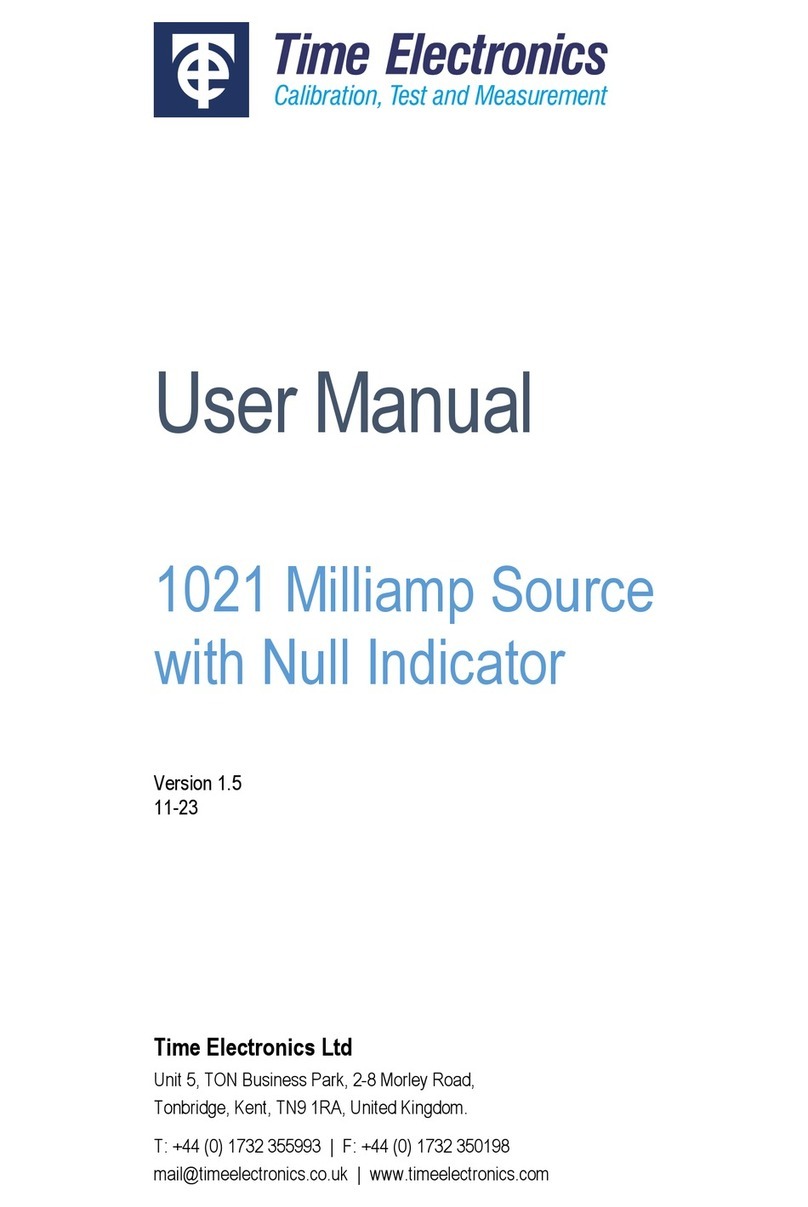
Time Electronics
Time Electronics 1021 user manual
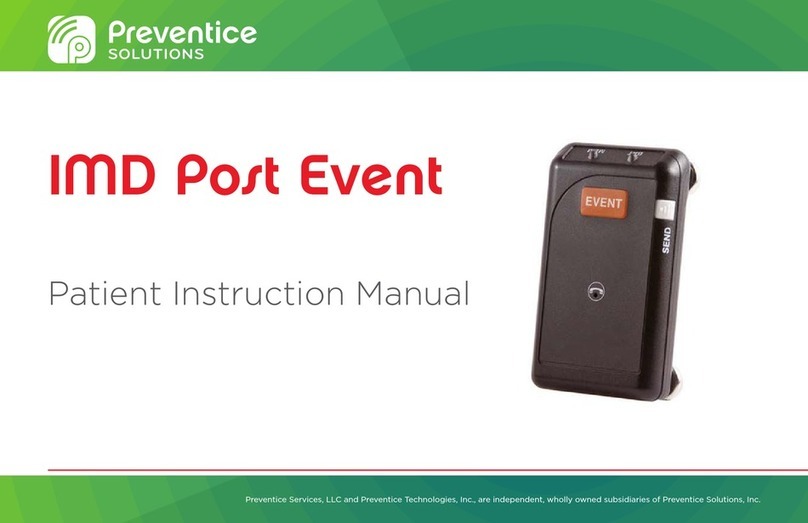
Preventice Solutions
Preventice Solutions IMD Post Event Patient Instruction Manual
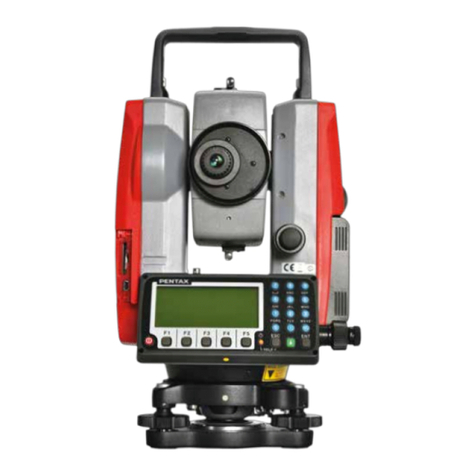
Pentax
Pentax R-200 Series instruction manual
![Lambrecht rain[e]observer operating instructions Lambrecht rain[e]observer operating instructions](/data/manuals/12/u/12umy/sources/lambrecht-rain-e-observer-manual.jpg)
Lambrecht
Lambrecht rain[e]observer operating instructions
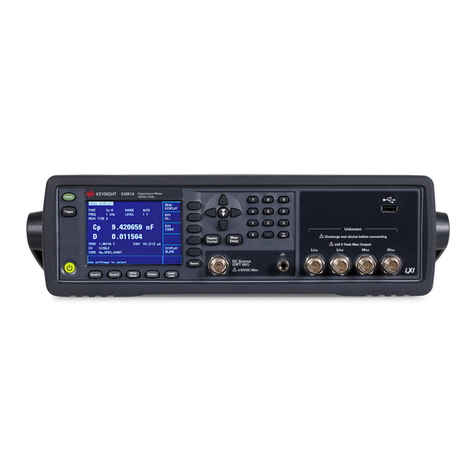
Keysight Technologies
Keysight Technologies E4981A Service guide
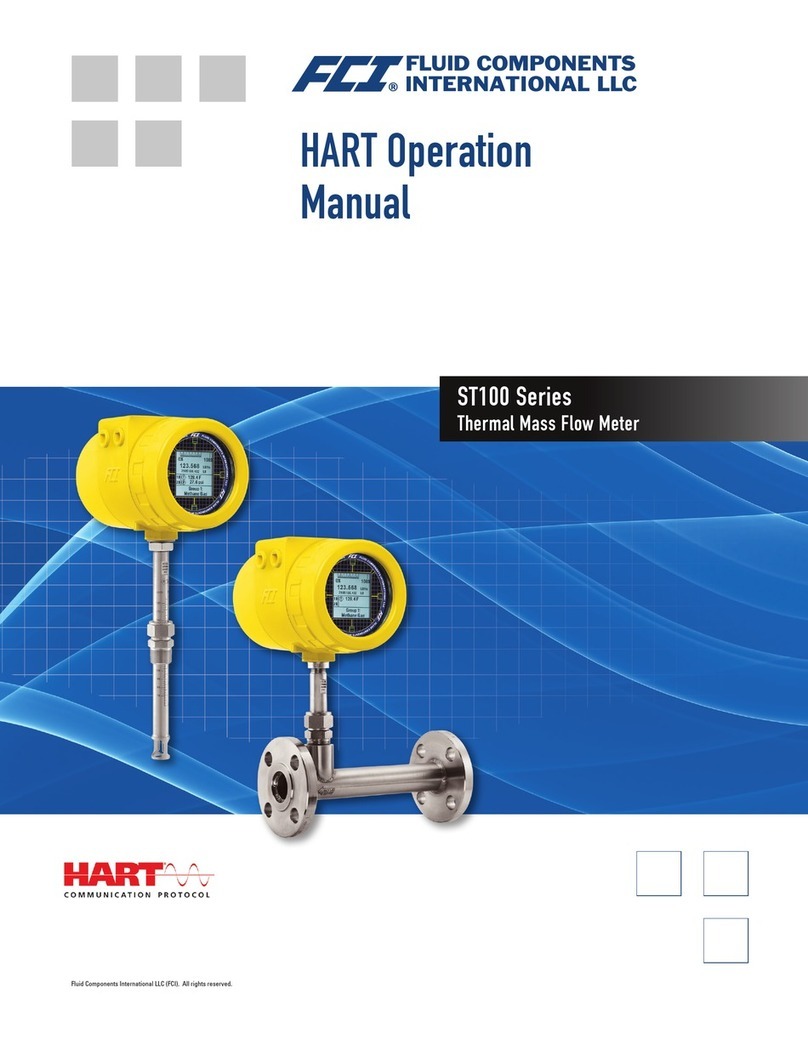
FCI
FCI ST100 series Operation manual
